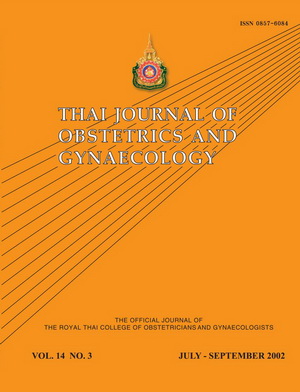Transvaginal Saline Sonosalpingography for the Assessment of Tubal Patency
Main Article Content
Abstract
Objective To evaluate the test characteristics of transvaginal saline sonosalpingography (SSG)
for the assessment of tubal patency in comparison to laparoscopy with chromopertubation.
Design Diagnostic test (prospective and blind comparative study).
Setting Infertile clinic and operative theater, Department of Obstetrics and Gynecology,
Bangkok Metropolitan Administration Medical College and Vajira Hospital.
Material and methods Tubal patency of 44 infertile women with previous unknown tubal function
was assessed by transvaginal saline SSG at infertile clinic. Transvaginal saline SSG was
performed with a 5 MHz transducer-ATL-HDI 3000 by injection 50 ml isotonic saline solution
into the uterine cavity through a pediatric Foley catheter. The collection of free fluid imaged in
the cul-de-sac was accepted as the evidence of tubal patency. Diagnostic laparoscopy with
chromopertubation was performed independently at operative theater on the following day.
The results of transvaginal saline SSG were compared to the findings from the diagnostic
laparoscopy with chromopertubation.
Main outcome measures The prevalence, sensitivity, specificity, positive predictive value (PPV),
negative predictive value (NPV), accuracy, false positive rate and false negative rate.
Results 42 of 44 women were finally recruited into the study because the procedure could not
be accomplished in two women. The results from transvaginal saline SSG were compared to
the findings from the standard diagnostic laparoscopy with chromopertubation. Transvaginal
saline SSG could detect tubal patency (either unilateral or bilateral) with sensitivity, specificity,
PPV, NPV and accuracy of 96.97%, 88.89%, 96.97%, 88.89% and 95.24% respectively.
Adverse events of transvaginal saline SSG included : mild pelvic pain in 30 (71.43%), severe
pelvic pain in two (4.76%) and shoulder pain in one (2.38%) of the women in this study.
Infectious complications were not found in this study.
Conclusion The results confirm that transvaginal saline SSG is a simple, well tolerated and
reliable screening method for the assessment of tubal patency in an outpatient setting with
minimal adverse effect. However, other confirmatory tests are required whenever bilateral
tubal occlusion is suspected due to possible false negative finding.
for the assessment of tubal patency in comparison to laparoscopy with chromopertubation.
Design Diagnostic test (prospective and blind comparative study).
Setting Infertile clinic and operative theater, Department of Obstetrics and Gynecology,
Bangkok Metropolitan Administration Medical College and Vajira Hospital.
Material and methods Tubal patency of 44 infertile women with previous unknown tubal function
was assessed by transvaginal saline SSG at infertile clinic. Transvaginal saline SSG was
performed with a 5 MHz transducer-ATL-HDI 3000 by injection 50 ml isotonic saline solution
into the uterine cavity through a pediatric Foley catheter. The collection of free fluid imaged in
the cul-de-sac was accepted as the evidence of tubal patency. Diagnostic laparoscopy with
chromopertubation was performed independently at operative theater on the following day.
The results of transvaginal saline SSG were compared to the findings from the diagnostic
laparoscopy with chromopertubation.
Main outcome measures The prevalence, sensitivity, specificity, positive predictive value (PPV),
negative predictive value (NPV), accuracy, false positive rate and false negative rate.
Results 42 of 44 women were finally recruited into the study because the procedure could not
be accomplished in two women. The results from transvaginal saline SSG were compared to
the findings from the standard diagnostic laparoscopy with chromopertubation. Transvaginal
saline SSG could detect tubal patency (either unilateral or bilateral) with sensitivity, specificity,
PPV, NPV and accuracy of 96.97%, 88.89%, 96.97%, 88.89% and 95.24% respectively.
Adverse events of transvaginal saline SSG included : mild pelvic pain in 30 (71.43%), severe
pelvic pain in two (4.76%) and shoulder pain in one (2.38%) of the women in this study.
Infectious complications were not found in this study.
Conclusion The results confirm that transvaginal saline SSG is a simple, well tolerated and
reliable screening method for the assessment of tubal patency in an outpatient setting with
minimal adverse effect. However, other confirmatory tests are required whenever bilateral
tubal occlusion is suspected due to possible false negative finding.
Article Details
How to Cite
(1)
Suttipichate, J.; Sroywattana, C.; Dejthevaporn, T.; Virojchaiwong, P.; Sripramote, M. Transvaginal Saline Sonosalpingography for the Assessment of Tubal Patency. Thai J Obstet Gynaecol 2017, 14, 223.
Section
Original Article


